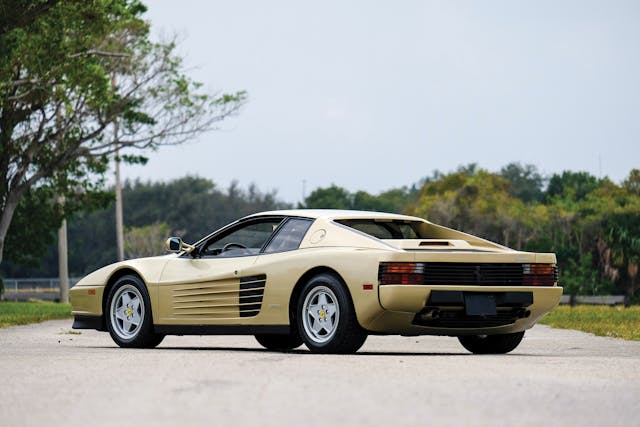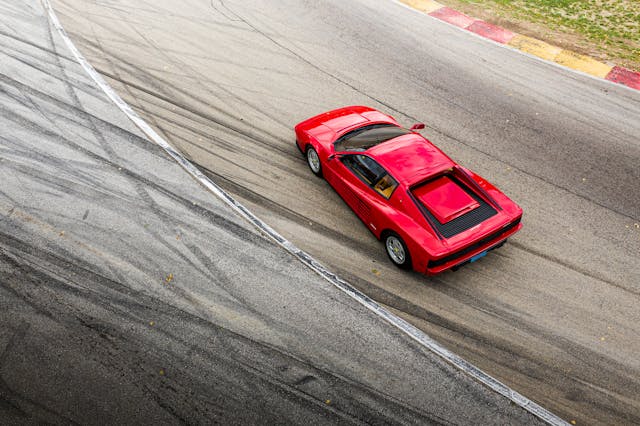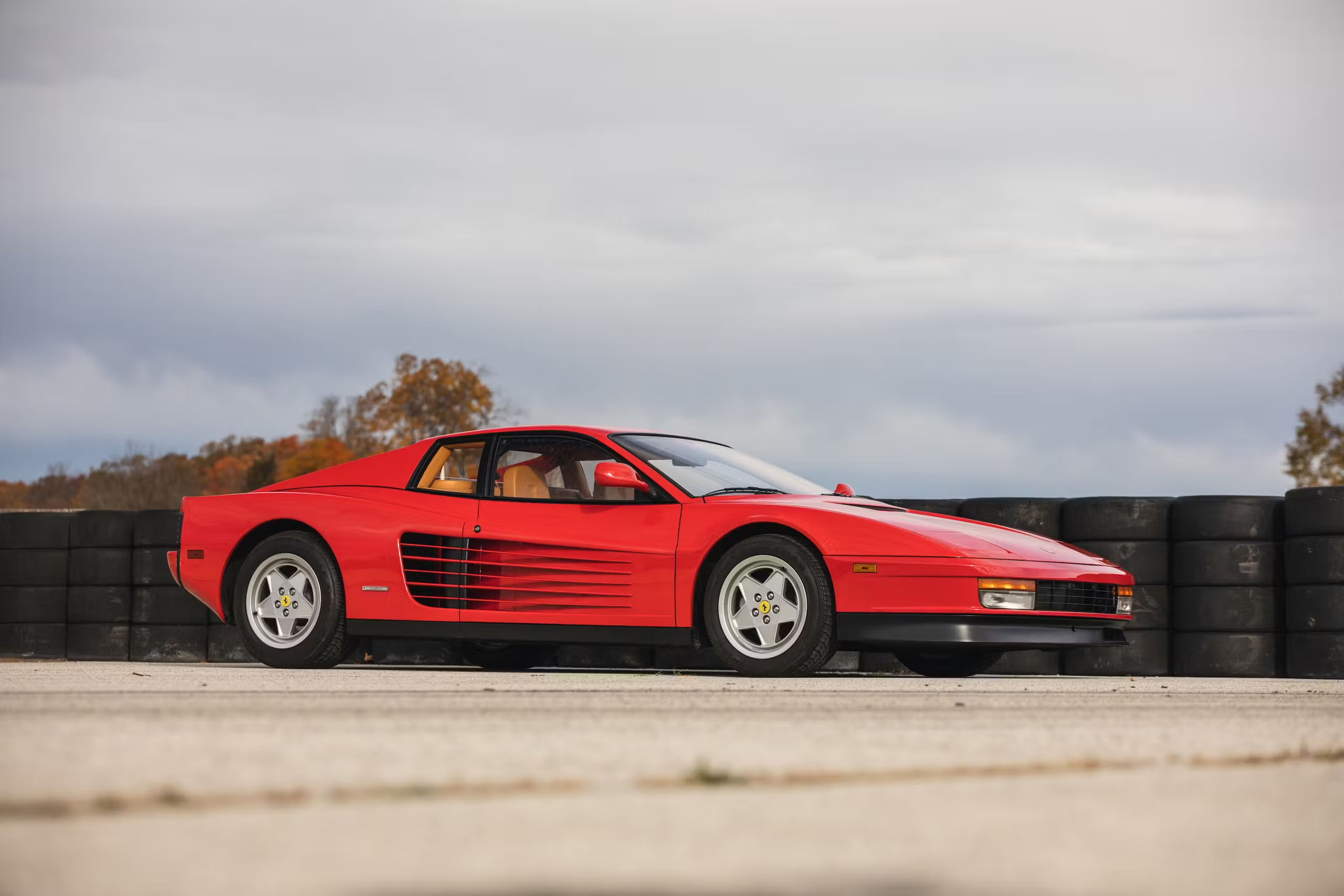Media | Articles
Your handy Ferrari Testarossa (1984–1991) buyer’s guide
Could the Testarossa be Ferrari’s most influential car? Designed as a high-end touring machine for the world market, the Testarossa possessed a mix of usability and refinement that added to the blistering performance and stunning style one expects from a Ferrari. Sergio Pininfarina called his design “an exaggeration in flamboyance,” but the Testarossa was more than just a wide stance and those dramatic side strakes. This stallion had it all: impressive engineering, revolutionary presence, and a platform that broadened Ferrari’s appeal.
Model overview
1984
It’s impossible to overstate the Testarossa’s impact on the automotive world in 1984. The 12-cylinder performance, unforgettable design elements (side strakes, flying mirrors, wedge styling, single bolt wheels, to name a few) and improved usability all helped grow Ferrari’s clientele.
These were customers looking to stand out in the Greed is Good era of the 1980s. The fresh exterior lines were crafted on top of a clean-sheet design under the skin; while the 4.9-liter flat-12 engine was closely related to the outgoing fuel-injected 512 BBi, the addition of four valves per cylinder not only improved power but helped meet the increasingly tighter emissions regulations around the world.

Meeting the world’s standards also meant making a world-class exotic, so the 1984 Testarossa also reduced NVH (noise, vibration, harness) which was especially important with Europe’s noise regulations. Comfort emerged as a priority for this seminal supercar. Upgrades in this vein included a lighter clutch (larger than the outgoing 512 BB), flatter passenger floor (easier entry/exit) and luxury equipment like power windows, power mirrors, leather-wrapped everything, and air conditioning. The latter was targeted for Americans living in hotter climates (cough, Miami).
Seeing as Testarossas came with nearly everything standard, the only options were exterior/interior colors, installing the stereo of your choice, and opting for a six-piece set of fitted, leather-wrapped luggage made by Schedoni of Modena.
Marketplace
Buy and sell classics with confidence
1985
Given that 1984 was quite the slam dunk for the folks in Maranello, it should come as no surprise that no major changes occurred this year.
1986

Like many performance cars of this era, the Testarossa’s metric Michelin TRX tires were ultimately tossed in favor of a more conventional set of rubber. Ferrari opted for 16-inch wheels but retained the single-bolt, center hub design. U.S.-spec models received a center high mount stop light (CHMSL) as per federal mandate, and the part was reportedly similar to what GM used on the C4 Corvette. A stunning droptop Testarossa Spider (built for Fiat chairman Gianni Agnelli) was crafted with a power-folding soft top and tonneau cover (much like a 1960s era Thunderbird Sports Roadster), and finished in silver with blue accents: Several topless TRs flooded the aftermarket in the years to come, but none save for the Spider had Ferrari’s official blessing.
1987

Ferrari installed dual sideview mirrors at the base of both A-pillars, which meant the death of the “flying mirror” design. The change came much to the dismay of onlookers, but cyclists that got too close to a passing Testarossa could breathe a bit easier. Models destined for the United States came equipped with a motorized passive restraint system for ’87, which automatically positioned the shoulder belt against the occupant but still required manual engagement of the lap belt. Smaller improvements included an improved air conditioning system, fuel level gauge, flywheel, and water/oil pump chain drive. For the U.S. market, Ferrari added a modified alternator pulley and smog pump as a mid-cycle update.
1988

The single-bolt wheels were changed to a conventional five-lug design for 1988, and it’s been said that Ferrari also made some significant, concurrent modifications to the Testarossa’s suspension. Luckily, the wheel’s flat five-spoke design remained true to the original concept’s mission of minimalist design. Inside you’ll find revised seats, and a new front hood design boasted an improvements to the water shield, locking mechanism, and insulation. A new gearbox and revised Bosch KE-Jetronic fuel injection system (replacing the older K-Jetronic) rested underneath the otherwise unchanged body.
1989
While catalytic converters were now standard for European-spec Testarossas, and all models received (another) new flywheel, there were relatively minor changes for Ferrari’s flagship this year. Updates included a revised gearbox, clutch assembly, steering column, and knee bolsters.
1990
Aside from improved engine crankcase sealing, very little changed this year.
1991
Again, no substantive changes here. With Miami Vice now off the airwaves for more than a year, the automotive poster child of the 1980s ended production with 7177 units built in total. The Ferrari 512 TR, sporting numerous mechanical and cosmetic changes, replaced the Testarossa for the 1992 model year. (The 512 TR’s changes are radical enough that some categorize it as an entirely different car. In any case, we consider it out of scope for this buyer’s guide.)
Before you buy

Let’s get the obvious out of the way: the 512 TR model’s improvements make it easier to live with, but is that car necessarily better? For some, the original Testarossa is irreplaceable—the purest of the breed. (That includes your humble author, who very much wants a flying mirror TR.)
While Euro-spec Testarossas show up for sale in the U.S. here and there, their unique emissions controls, lighting, and associated wiring could be considered illegal depending on your state’s laws. There’s also the chance that a Euro-spec car contains a poor-quality conversion—performed by gray market importers, not the Ferrari dealership—that could turn into a repair nightmare. Do yourself a favor and check the VIN first to ensure you cover all bases.
The aforementioned water and oil pump chain upgrade, from 1987, should be retrofitted onto older Testarossas when doing an engine-out service (for the cam belt). The cam belt service itself is usually over $5000 and should be done every 15,000 miles, or about every five years. This is a mandatory service and is one of many reasons why a well maintained example—with paperwork to prove it—will always command a premium over a Testarossa without sterling service history.

When going on a test drive, make sure to hear the motor run when cold, as Ferrari flat-12s behave differently than most classic engines. The Bosch fuel injection system doesn’t perform as effectively as a modern car’s, but it shouldn’t need significant throttle management (as with a bad carburetor) to keep idling when cold. Also check for smoke from the tailpipes, as there should be none after a few seconds of idling. Once idle has leveled, drive conservatively until engine (and gearbox!) oil temps warm up. If the gearbox feels difficult to use, it might need a longer warm-up time. Once warm, the engine should rev smoothly and effortlessly, but keep in mind that older EFI systems tend to run rich at full throttle, so you might see a just little smoke in the rear view mirror.
Sometimes, a poorly running engine could just need the so-called Italian Tune-Up. These flat-12s tend to accumulate carbon build up if not run up to the upper rev range on a regular basis. You shouldn’t necessarily trust a seller who suggests that all their car needs is said “tune-up,” unless they are willing to perform it for you in your presence. When the powertrain is at operating temperature, several runs to its 7000 rpm redline in third gear is all that’s needed. (Provided you do so when highway conditions allow, of course.)

Tune-ups aside, a Testarossa test drive should proceed much like it would any other collector car (i.e. make sure every feature, button, and switch works as intended) but be extra careful of the tires, especially on TRX-equipped Testarossas: Dry rotted tires are commonplace on low-mile vehicles and performance drops significantly because of it. The TRX metric tires are painfully expensive to replace, but they are usually available from vintage tire companies. If the rubber is 7+ years old, factor tire replacement into the asking price in order to safely enjoy driving it on the road.
The original, single-bolt wheels used on Testarossas can come off at speed, so make sure the splines on each wheel are undamaged and everything is torqued to spec. Listen for clunks in the suspension, any unexpected braking behavior, and any other noise that detracts from the legendary Ferrari powertrain’s demeanor. If you hear something that sounds off, make a mental note to price the possible diagnosis/replacement before making your offer. Speaking of offers, you may be able to adjust the price if the Ferrari toolkit is missing; be prepared to pay more if the Schedoni luggage set is included with purchase.
Ferrari Testarossa values

The Hagerty Valuation team has gained significant insight in to recent transaction prices for the Ferrari Testarossa, but please check here for the most up-to-date values. Since four months ago, Testarossas are up 42 percent for #2-condition (Excellent) cars and 76 percent for #1-condition (Concours) cars. No Ferrari saw a higher increase over that same time frame, but like many classic and modern Ferraris, Testarossas shot way up in 2014–15. Testarossas experienced a value increase of 27–34 percent in the first part of 2015, with a retreat in 2019 and early 2020 (-13 percent from January 2019 to January 2020). After that they rebounded big time and are now at an all-time high.
How high, you ask? At this time in 2014, a #1-condition (Concours) Testarossa was worth $64,000. That money won’t even buy you a #4-condition (Fair) car today, which as of this writing is worth $77,500 on average for 1984 models. The range goes all the way to $211,000 for pristine #1-condition cars. Notable sales in recent memory include the Miami Vice Testarossa (no sale at $475K), actor Don Johnson’s personal example (sold for $110,000), the aforementioned 1986 Testarossa Spider (sold for $1,349,239), and a one-owner time capsule car (sold for $319,000).

Hagerty insurance quotes for Ferrari Testarossas are up eight percent over the last three years, while quoted values are down three percent over the last three years but up 18 percent over the last five years. Despite the popularity of 1980s and 1990s cars among younger buyers, the base for Testarossas skews older, probably thanks to high prices and astronomical running costs. Fifteen percent of quotes come from pre-boomers (who represent just 7 percent of the market), while 0 percent of the quotes come from Gen Z (they make up 5 percent of the market).
The Testarossa lives in a world with very few peers. The car knocked the socks off the motoring press in period, and it carved its way into the cultural canon thanks to TV appearances, posters, scale models, and placement in the popular video games (Out Run and Test Drive). The Testarossa had it all, and for those interested in owning one, the best advice still boils down to buying one that you truly love, in the best condition you can afford, with a documented service history if at all possible.














